‘What is the use of a house if you haven’t got a tolerable planet to put it on?’ — Henry David Thoreau
As it is now a year since I began my journey as an environmental activist last October, starting with Extinction Rebellion and continuing to the fight against HS2 (the high-speed train line from Euston to Birmingham, which will cut straight through the heart of 108 of the UK’s remaining ancient woodlands), it seems an appropriate time to reflect on my experiences – including a recent event that caused me to lose my voice. There’s a certain poetic irony in losing my physical voice while trying to speak for the birds and trees and woodland creatures that have no voice – but I hope this blog will help me to plead their case.

Extinction Rebellion: Affinity and anarchy
I grew up in the US, where – even as far back as the early 1970s – scientists were already concerned about the impacts to the ozone (the part of the atmosphere that protects the Earth from the sun’s harmful rays) from global warming, which I have written about at length here. As a young adolescent, I was deeply disturbed by this, convinced the world would end in my lifetime. Back then, there were no teenage activists like Greta Thunberg around to confront the system – if so, I would have joined them.
My first encounter with Extinction Rebellion (XR) was in early April 2019. I was taking an alternate route home from work via the South Bank Centre when I heard a loud commotion coming from Waterloo Bridge. There, around 100 rebels were occupying the bridge and obstructing traffic. While amused at their hippie-style, rainbow-hued clothes, banners and makeshift tents, I felt a deep affinity with their message about climate change and their demand for the government to take this seriously, as this echoed everything I had been reading while researching topics for investigative reports for my then-job as editor-in-chief of an online investigative journalism start-up.
After the grim findings of the air pollution report I had recently commissioned and contributed to (see here), which revealed that inhaling London’s air was equivalent to inhaling a half a pack of cigarettes daily, it was delightful to see London’s normally grey and congested urban landscape transformed by their artfully arranged pop-up gardens and vegetation. I found the innocent-seeming joy emanating from the musicians strumming folk and reggae, and their shamanic (shambolic?) dancing uplifting and inspiring, so I determined to find out more about XR.
Towards the end of September 2019, a team of representatives from XR came to do a press conference at Reach (the commercial wing of the Mirror newspaper group in Canary Wharf, where I was then working) ahead of the planned two-week International Rebellion starting on 7 October. I went to one of their London-based meetings and immediately signed up to join the Rebellion and help with their media work.
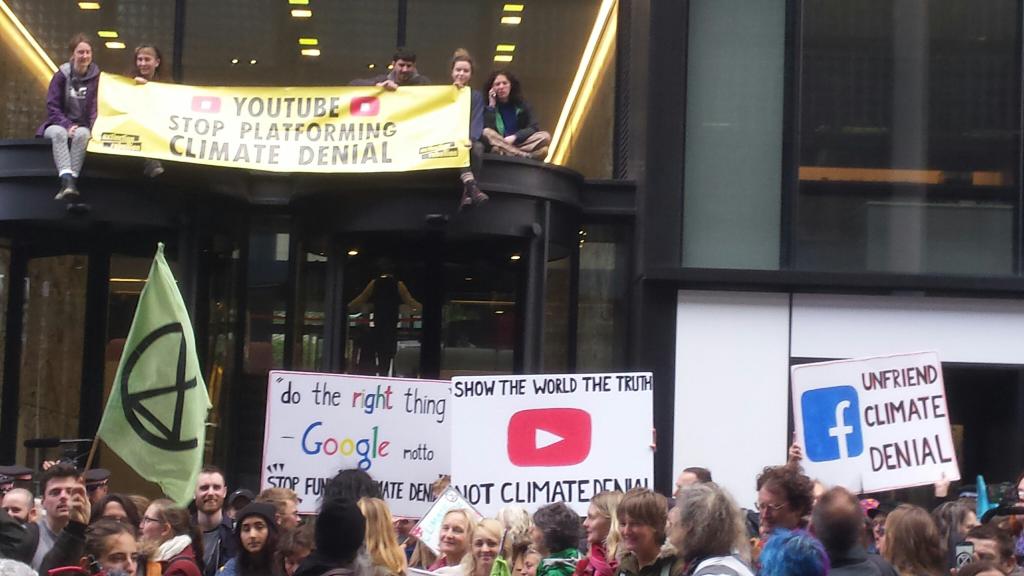
I was soon contacted by an Oxford professor about joining the SE Press Working Group, whose task was to write press releases and articles for the national and regional newspapers about the Rebellion. This group comprised mostly white middle-aged female PR and media professionals from around SE England. As most of us were new to XR and so not clued in overly about the daily plans for the Rebellion – usually decided on the hoof and relayed through a plethora of social media channels – it was a challenge to keep up with all the various protest actions taking place all over London, while attending and then writing about them, which felt quite overwhelming, chaotic and confusing at times. We quickly decided to work from a generic press release template for each event, adapting it for our respective regional newspapers.

I also joined my local XR ‘Affinity Group’ in Marlow just before the Rebellion began, but as I hadn’t had time for a proper induction or to get to know my fellow local rebels, my initial efforts to interview them for press quotes were viewed suspiciously – understandable given XR’s reasonable distrust of journalists. As most of my local group were seasoned rebels, they seemed to know exactly what they were doing as soon as we arrived in London, whereas I quickly lost them amid the crowds at Whitehall. Eventually, a few of them talked openly to me about their reasons for joining XR, and I amassed some usable quotes. But I quickly realised gaining the trust and support of my local affinity group meant not only joining actions in London, but attending as many local evening meetings and discussions as I could.
One local event was actually a climate change comedy night in High Wycombe, which admirably managed to be funny while presenting some very hard-hitting climate facts. This included an infographic showing the spectrum from climate-change denialism to scepticism to the ‘cautious’ to the ‘concerned’ (eg those already ‘doing their bit’ by recycling, petitioning, using renewable energy, etc) and finally to the ‘alarmed’ – those deeply anxious and angry about the climate emergency and the failures of government to protect us — which was where most rebels found themselves on the spectrum.
The October 2019 Rebellion

The October Rebellion was planned with the aim of targeting the major tourism, financial, retail, media and government centres of London, with rebels occupying areas in an effort to stop ‘business as usual’ and force government leaders to confront the climate emergency. Most of the actions were centred in and around Whitehall, Westminster, The Mall, Trafalgar Square, Victoria Embankment, Downing Street, and Lambeth and Westminster Bridges, with additional protests in locations like Oxford Circus, Bank and Canary Wharf. Sub-groups, including Doctors for XR, Scientists for XR, Animal Rebellion, Ocean Rebellion and others featuring different threads of the extinction theme, also held actions in relevant locations.
I usually headed first to Trafalgar Square, from where I then joined marches and protests in and around Westminster and Whitehall, typically punctuated with dancing and music from the colourful samba bands. At the time, the famous Extinction Rebellion ‘Tell the Truth’ pink submarine boat was stationed in Oxford Circus, where celebrities such as Emma Thompson and Guardian columnist George Monbiot addressed the crowd before being dispersed by police – sometimes quite forcibly. Police aggression towards protestors usually provoked a chant of ‘We’re not violent, how about you?’

One evening after a day’s marching, I was sitting with a crowd the drizzling rain in Trafalgar Square, listening to a talk about the need to organise citizen assemblies, when someone asked if anyone was willing to be arrested. I suddenly thought, ‘Why not?’ and joined a band of young women ranged around the base of Nelson’s Column with their arms linked and knees covered by a plastic sheet – all singing and in good spirits, despite being soaked through.
Someone else passed through the crowd handing out ‘bust cards’ with instructions on what to do if arrested. While it didn’t concern me too much when the police began to surround us, I was a bit worried about how my husband would feel if I had to phone him from a jail cell, and also suddenly realised I’d left some medication at home.
As I was pondering this, a woman approached me, saying, ‘I feel very strongly you should not be arrested – you need to save your beautiful sword. Please, go home now.’ While I wasn’t exactly sure what she meant by ‘saving my beautiful sword’, I knew I hadn’t had any arrestee training yet, so didn’t feel ready. So I decided to take her advice and go home, stopping to watch in mesmerised awe as the mysterious Red Brigade (a group of men and women clad head to toe in red, with white mime-face makeup) enacted a solemn ceremony on Whitehall, which seemed to evoke a deep sense of grief and mourning for the planet.

Although I did get the arrestee training shortly afterwards, I realised it would not serve my purposes to be arrested. Yet in the coming days, it seemed progressively harder to avoid. While some police, such as the policewoman I spoke to as her fellow officers herded us out of the Bank area where we were protesting financial institutions’ support of fossil fuel industries, had initially seemed sympathetic, even laughing and joking with us or joining in the dancing, as of the 11th – only four days into the Rebellion – at least 1,000 activist arrests had been made, and were increasing. Tents were slashed open and goods confiscated from the occupied area of Trafalgar Square, while aggressive police carried protestors away forcibly, despite many of them being locked on (usually by supergluing themselves to statues or railings).
Suddenly, at 9pm on the 14th, the police banned all of the Extinction Rebellion protests in a move deemed ‘chilling and unlawful’ and ‘an attack on democracy’
Suddenly, at 9pm on the 14th, the police banned all of the Extinction Rebellion protests in a move deemed ‘chilling and unlawful’ and ‘an attack on democracy’. Green Party MP Caroline Lucas described the ban as a ‘huge overreach of police power’, while advocacy group Liberty said it was a ‘grossly disproportionate move by the Met and an assault on the right to protest’. Lawyers for XR launched a judicial review of the ban. But despite this police action, XR continued its protests at the Department for Transport, at which leader Gail Bradbrook was arrested after climbing atop its entrance, and the Google and YouTube headquarters, where Guardian journalist George Monbiot and Green Party leader Jonathan Bartley were also arrested.

However, it was the ‘surprise’ actions of a rogue contingent of XR activists (including a few Christian Climate Action members) who went against the general advice from many in XR with an action at Canning Town tube, which held up the trains from running during the morning rush hour. A handful of activists climbed on top of and then glued themselves to London Underground trains, thereby preventing many in the predominantly working-class region of East London from getting to work. I was against this action, as I knew only too well how unfair this would be to any London commuter, and how unlikely it was to gain any sympathy.
The resulting backlash in the press following the Canning Town incident was significant, and had the effect of splintering XR. Although the London Rebellion hadn’t officially ended until the last big action at Oxford Circus and Big Ben, in which activists climbed structures to lock on and unfurl banners announcing a Citizens Assembly and ‘No pride on a Dead Planet’, the negative press about Canning Town and increasing arrest momentum led many of my fellow local rebels to stay home and seek ‘regen’ (peaceful, healing, peace-affirming self-care actions). Other actions involved targeting airports.

When I later met up with members of the SE Press Group in London, we discussed the Canning Town incident and how this affected the success (or lack thereof) of the Rebellion. Over the next few days and weeks, this incident provoked heated debates across many XR social media channels, with some groups – including what I termed the ‘virulent vegans’ – seeming bent on making Extinction Rebellion all about their own particular cause, which had a dis-unifying and disarming effect.
Although I briefly considered joining a group going to Madrid for a protest around COP 25, in the end I did not go, preferring to take some time out to reflect and reconnect with myself, God and nature. Some members of my local XR group kindly provided some much-appreciated ‘regen’ sessions, however I felt I needed a different kind of regen – one where I could feel I was actively helping the environment. This led to my next phase of environmental activism.
It’s not really about a railway…
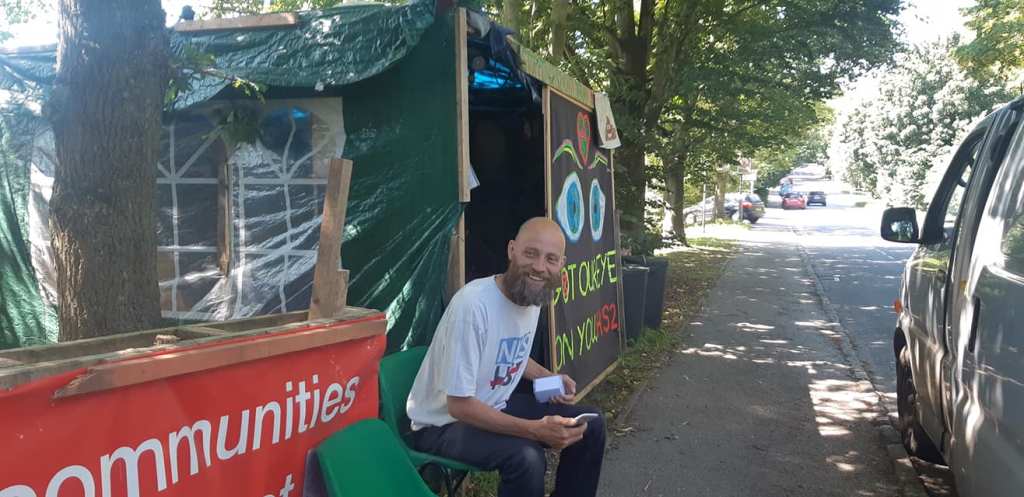
On the day of the Canning Town incident, a few of us from my local XR group decided not to go into London, but to support a local protest at Link Road in Great Missenden (near the Roald Dahl Museum, about a 20-minute drive from my house) instead. There, two hippie-ish, but very gentle-natured, well-informed and quite decent-seeming ‘tree protectors’ were camping out to stop the mature trees along Link Road being felled to make way for a haulage road for the HS2 railway project. Several local residents – most of whom were not aligned with XR, though some were members of the Stop HS2 campaign, the existence of which pre-dated Extinction Rebellion by a good six years – were also actively supporting this protest to fight HS2’s impact on our Chilterns Area of Natural Beauty (AONB).
One Link Road protestor, a member of the River Chess Association, told me the planned drilling into the River Chess’s chalk aquifers to create the tunnels for HS2 would be a major cause of pollution of the drinking water for local and London-based Thames Water and Affinity Water customers. (In the latest update, because pollution was seen immediately as the drilling into the chalk aquifer commenced, Affinity Water decided to cease abstracting from the two bore holes that descend deep into the source of the River Chess’s spring. This, and the agreement between HS2 Ltd and Buckinghamshire County Council to forego taking down most of the trees on Link Road, are two very small victories in the battle with HS2.)

This same protestor also explained that drilling into the aquifer would deplete much of what little remains of the once free-flowing and extremely rare chalk stream, which is home to many threatened wildlife species – including water voles (on which the character of Ratty in Wind and the Willows is based – now Britain’s most endangered species), ospreys, water rails, mayflies, brown trout and brook lamphreys, and the very rare, critically endangered Bechstein’s bat, which inhabits the Link Road trees. Please note: HS2 Ltd does not have now, nor has it ever had, any licences to disturb or destroy bats’ habitats. (I later checked this out with HS2 Ltd and its allied vehicle, Natural England, both of which took several weeks to reply, and in the end only returned some vague PR spin that did nothing to address my complaint; I also attempted to get answers from the Bat Conservation Trust, and discovered they had also seemingly sold out to HS2 or could/would do nothing to stop the destruction of the bats’ habitats.)
Another knowledgeable Stop HS2 protestor explained that not only would this high-speed railway destroy our AONB, but it would also inevitably damage the hearing of local schoolchildren because the decibels of the screeching, fast-moving train would exceed the limits for safe noise levels. While I knew trees provide a vital first-line defence against respiratory conditions such as asthma and other health impacts of air pollution as they filter harmful carbon dioxide (CO2), I hadn’t considered the impacts of noise pollution until then.

As I made successive visits to Link Road and other nearby resistance camps (Dews Lane and Harvil Road), I met many local farmers threatened with eviction from their houses, farms and lands to make way for HS2 and its haulage works roads. According to several I spoke with, HS2 represents the greatest compulsory land-grab by the government since World War II – it is not at all about a railway, but is a massive government gambit to steal land from farmers and reclaim it for other purposes (for example, once the HS2 building work is done, the once-biodiversity- and soil-rich farm lands will likely become useless brownfield, and then be sold off for housing developments to profit private companies).
Many of these farmers have been bullied, threatened and intimidated into compliance, despite only being offered a pittance in comparison with the real value of their homes, farms, businesses and lands
Many of these farmers have been bullied, threatened and intimidated into compliance, despite only being offered a pittance in comparison to the real value of their homes, farms, businesses and lands; they have also been told they will not receive any compensation until after the works are completed. In many cases, their properties are literally miles away from the proposed railway path, compounding the sense of injustice. Most have welcomed the resistance campers on their grounds, as at least this has provided a delaying tactic; however others, like the Ryalls, have had their lives, businesses and lands (in their family’s possession since Shakespeare’s time) completely destroyed.
I later interviewed the Ryalls as I had heard one of their staff had committed suicide because of the unjust situation they face; other farmers I spoke with have revealed the terrible mental, emotional and financial suffering they have experienced as a result of having their homes and livelihoods effectively stolen from beneath their feet.

Until I met these protestors and learned of HS2’s looming impacts on families, nature and people’s health, I was completely unaware of the scale, cost, and lasting environmental and health damages HS2 will cause. Like many, I had ignorantly assumed that as a train, it would be good for the environment. However, HS2 is clearly not really about a railway; there is obviously another, more dubious agenda going on. It will also not be carbon-neutral not for 120 years – by which time it will be too late to do any good for the environment, and in fact will harm it greatly.
The UK is one of Europe’s least-forested nations, with only 13% tree cover left – therefore the carbon sink that would have been provided by the 108 ancient woodlands in HS2’s path will be lost forever – not to mention the loss of vital flood defences this represents
The UK is one of Europe’s least-forested nations, with only 13% tree cover left – therefore, the carbon sink that would have been provided by the 108 ancient woodlands in the path of HS2 will be lost forever – not to mention the loss of vital flood defences this represents. And there is no way HS2’s pathetic handfuls of newly planted saplings will reduce CO2 sufficiently to keep us all breathing healthily.
As my eyes began to be opened to this horrendous and tragic ecocide unfolding literally on my doorstep, I realised that this indeed is Britain’s Amazon, and therefore I must throw all my energies into fighting it.

Further HS2 revelations and actions
Over the next weeks and months, all through the winter and into the new year, I continued to join various protests and resistance camps at Link Road and other sites along HS2’s proposed 125-mile route from Euston to Birmingham – Harvil Road, Dews Lane, Denham Country Park, Colne Valley Nature Reserve, Steeple Claydon, Poor’s Piece, Cubbington Woods, Crackley Woods, Calvert Jubilee Nature Reserve and Jones Hill Wood in Wendover.
I became determined to write an investigative report to expose HS2’s crimes, and eventually completed a short report – initially published on the Ecologist website, where it went viral overnight, and subsequently republished here and on the Stop HS2 website – highlighting the threatened, rare, endangered and legally protected wildlife species at Denham Country Park and Colne Valley Nature Reserve, which will be destroyed forever by HS2. I included all the wildlife laws (UK, EU and international) HS2 is breaking, and backed it up with ecologists’ evidence, checked by a wildlife biologist.
I have tried to urge other journalists to collaborate with me to expose HS2 further; to my knowledge, there has never been a thorough ‘follow the money trail’ investigation to expose the corruption behind HS2’s endlessly escalating costs (the most recent projection is a whopping £231.32bn). As this project is being paid for with taxpayers’ money, it raises immediate questions as to who stands to profit from it (apparently HS2 Ltd’s CEO Mark Thurston is earning ca. £650K a year for his ‘contributions’; I have heard HS2 construction workers, and the hired police and National Eviction Team [NET] thugs that enforce its evictions earn £250–£350 per day, which is a lot of money for them to stand around all day as most of them seem to do. Clearly, this is money that should be funding our cash-strapped NHS and helping struggling businesses, not this travesty!).
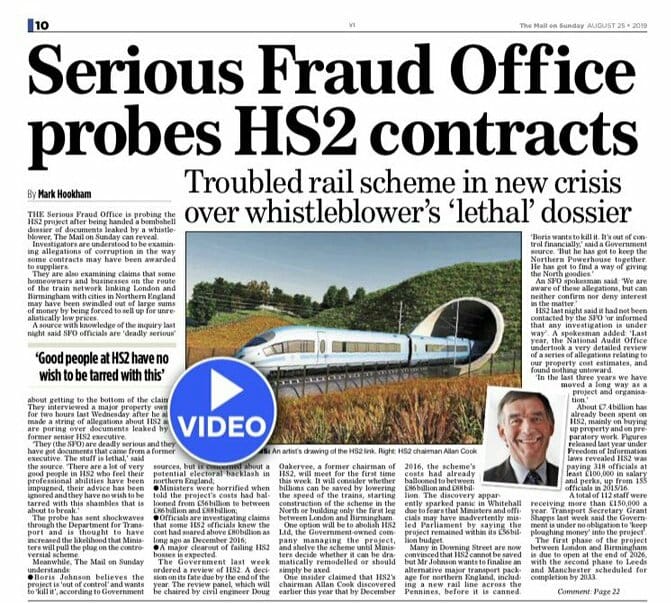
I have also witnessed HS2’s supposed ‘ecologists’ at work; they turn up, poke a stick around in a bush for a few minutes, and leave – there has never been any evidence of actual mitigation (apart from a few planted saplings, often left un-watered until they die) or translocation work to remove any threatened species.

As I began to question this, one of the Stop HS2 founders alleged there was copious evidence linking the HS2 project to trade deals with China as part of the latter’s Belt and Road Initiative, which intends to link routes from China across Europe. This seems a potentially likely explanation for why the project is being pushed through by the UK government, despite the fact the vast majority of the British populace never asked for and clearly do not want this railway. I am sure the facts will eventually become clear, but I do wonder why this project is not being challenged or investigated properly – most newspaper coverage only ever presents HS2’s positive PR spin, and (like Natural England, the Environment Agency and Buckinghamshire County and other entities) seem either to have taken backhanders from HS2 Ltd or otherwise been silenced.

Fortunately, BBC naturalist and presenter Chris Packham has taken a clear stand via his Stand for the Trees legal petition against HS2, launched in early 2020. I was at the resistance camp in Crackley Woods when everyone shouted with jubilation as we learned the lawyer representing the case had amassed irrefutable evidence showing HS2 had no licences for the bats and other wildlife ecocide it is committing.
Sadly, although Packham’s lawyer did an excellent job of arguing this evidence, his petition has so far been unsuccessful. And although work on HS2 was supposedly suspended while the Oakervee Review was being considered and before the PM officially gave the go-ahead in February 2020, the vegetation-clearing work and tree-felling had actually continued throughout Johnson’s supposed review, throughout the spring nesting season (which is illegal), and throughout the coronavirus lockdown. While the lockdown has certainly proven that no one needs this ludicrously expensive white elephant with its spiralling and vastly unjustifiable costs as so many workers have successfully transferred to working from home, even that has continually fallen on deaf Parliamentary ears.

I have also witnessed and recorded ample evidence of – and even personally been threatened by – violently aggressive acts against peaceful protestors by HS2 Ltd’s bevy of hired goons (construction workers, Metropolitan and Thames Valley Police, and NET officers) in the course of my visits to several HS2 sites.
Some activists who have been violently assaulted have shown me X-rays of broken collarbones and fingers, and I have been present when NET officers have cut tree protectors’ precarious zip lines, causing them to fall into streams or onto cherry pickers and tree grabbers.
Throughout my weekly visits to protest sites and woodland camps, which I continued to do during the Covid-19 lockdown period, I have met so many truly warm, compassionate, witty, dedicated, decent, caring and truly awe-inspiring activists, whose heroism and selfless commitment to protecting Britain’s countryside by persevering and camping out through all weathers is incredibly inspiring. Joining them in the front-line fight against HS2 has made me feel far more engaged in actively protecting the environment than marching through the streets of London with XR ever has. I began to ask the question, as had many of the other camp warriors, where was Extinction Rebellion, and why wasn’t it more actively engaging in this fight that so clearly constitutes Britain’s Amazon?
XR joins the fight against HS2

While I knew a few other XR members who had been actively resisting HS2 for several months – apparently, some scaled trees in an act of resistance at Colne Valley as far aback back as April 2019 – XR’s involvement with HS2 on the whole was a more gradual process, eventually culminating in a new channel called HS2 Rebellion, which became more publicly active towards the end of May 2020.
According to its Facebook page, HS2 Rebellion is ‘an alliance of various groups and individuals who are campaigning against HS2’ – including Stop HS2, Stand for the Trees, Save Cubbington Woods, Crackley Woods protection camp, Wendover Active Resistance camp, Harvil Road protection camp and Extinction Rebellion’– and alongside other XR splinter groups such as Wildlife Rebellion, Animal Rebellion and Global Rebellion.
One of HS2 Rebellion’s first organised protests, from 20–27 June 2020, was a high-profile Rebel Trail march, which galvanised XR and other local protestors to hike the full 125-mile length of the HS2 route from Birmingham Curzon Street to Euston Station in London. This helped focus media attention and divert some funding and needed supplies to the various HS2 resistance camps.
Although an untimely knee strain prevented me from joining the march, I at least succeeded in organising several of my local XR group to join, and made my presence felt by providing them with several hand-painted placards and clothing sashes highlighting the various wildlife species threatened with ecocide by HS2 (hedgehogs, barn owls, great crested newts, eels, European water voles, water bugs, hazel dormice, common shrews, stag beetles, tawny owls, European badgers, harvest mice, muntjac deer, polecats, snipes, teals, lapwings, and a range of bats – Leisler’s, Natterer’s, Serotine, Brandt’s and Bechstein’s).
Shortly after this march, HS2 Rebellion joined with other local groups to try to prevent HS2’s destruction of the Calvert Jubilee Nature Reserve, with several XR activists camping out there to delay the nature reserve being razed to the ground. Unfortunately, this tragic devastation went ahead after XR’s Red Brigade was despatched to perform their solemn mourning ceremony there, as they have done at other sites once the battle to save the trees appeared truly lost.
Sadly, efforts to save the much-loved, 250-year-old, 2015 ‘Tree of the Year’ Cubbington Pear Tree – including an action in which HS2 Rebellion activists turned up to sing to the tree – have thus far failed; even after over 20,000 petition signatures forced it to be addressed in Parliament, it has so far only received a temporary reprieve, and is still due to be felled soon.
Increasingly, and supposedly at the invitation of the HS2 resistance camps, young XR activists had begun to turn up at several of the camps, often remaining within their own cliques while drifting casually between the various camps. While I heard rumours of disputes over funding and leadership in the camps between the older members and the newer arrivals, with some grumbling about XR activists causing rifts by trying to impose XR’s values and culture on the camps (apparently, HS2 Rebellion had been awarded a total of £32,000 to help fund the camps, but had only distributed the funds to those camps that agreed to abide by XR rules), I have been assured these issues have since been resolved.
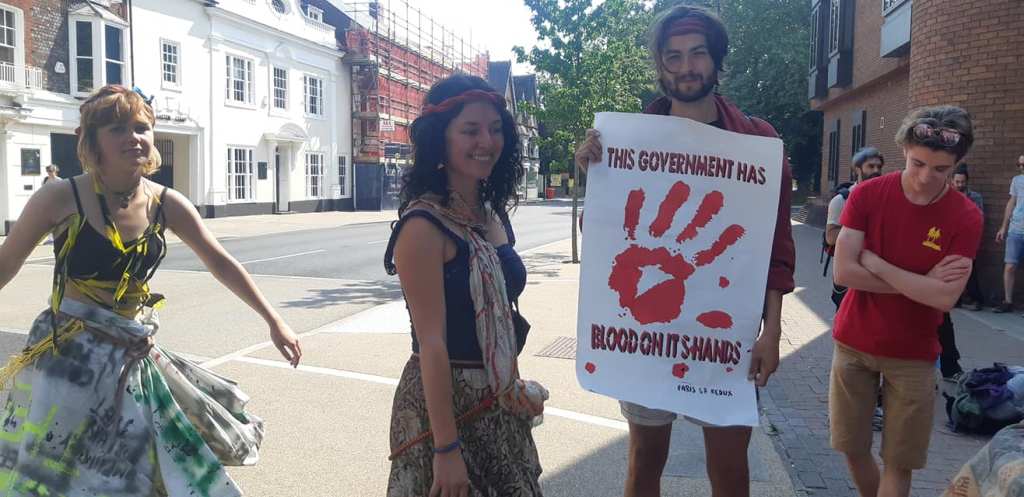
However, where there was a more harmonious integration between the younger XR campers and the veterans, this has been very effective. Some XR activists have got stuck into the camp life and have valuably contributed fresh skills, enthusiasm and creativity in places such as Jones Hill Wood in Wendover, where they recently helped host a family-friendly ecological discovery day to showcase these beautiful and biodiversity-rich woods, which has helped to increase support for the camp among local residents.
The two-week XR Rebellion in London in September 2020 was massively curtailed by a heavy police presence, who eventually confined most of the protest to a single square in Westminster, supposedly due to the Covid-19 pandemic restrictions. This Rebellion included a one-day march around Euston, where HS2 Rebellion activist Larch Maxey was among others camping in trees on the grounds near the building works until their recent arrest and eviction.
Up until this time, I had only participated in and written press releases about a few local XR actions ahead of the Rebellion, including a few Black Lives Matter protests and an action involving unfurling ecocide-themed XR banners on bridges over the M40, but I did feel motivated to join this particular London-based protest, as well as an ocean-themed event.

Towards the end of XR’s London Rebellion, there was a planned attack on Murdoch’s press empire as rebels mounted artfully erected wooden cranes to blockade the entrance to several printing presses. I had only heard about this after the fact as the action was kept secret to avoid police intervention. Although it only really caused a temporary delay to papers like The Sun reaching its mostly older newspaper-reading fans – so was actually more of a symbolic gesture, given that most people get their news digitally these days – It provoked quite a backlash in the press, with several arrests made in the following days and substantial fines imposed on the activists involved.

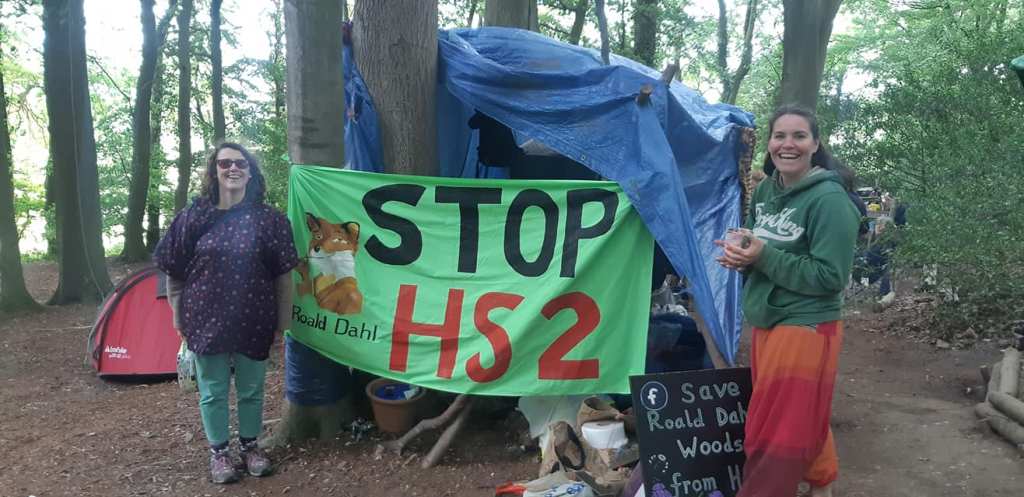
Swampy and the Battle of Jones Hill Wood (aka the ‘Battle of the Bean Can’)
Shortly after this, the dreaded 1st of October arrived – the day anti-HS2 activists referred to as ‘National Tree Killing Day’ as it signalled the day HS2 would ‘begin’ felling trees at the various threatened sites. Despite being recently antagonised by XR, the UK national media suddenly switched tack and rushed to report on this, with BBC, ITV, Daily Mail and other cameramen and journalists turning up in droves to film at the Jones Hill Wood resistance camps.
Why the UK national media was suddenly so interested after months of unreported clashes between HS2 and the dedicated activists at other resistance camps is hard to say – although clearly they were expecting some sensational action, even if their news coverage of the events in Jones Hill Wood left a lot to be desired. No doubt they were also drawn because of the higher-profile XR activist presence and the fame of these woods’ associations with UK author Roald Dahl, and the boldly courageous dedication of camp protectors such as West Berkshire Green Party Councillor Steve Masters, who had been living in a treehouse in the section of the woods threatened with eviction. However, it seems their presence was most likely inspired by the rumour (subsequently confirmed) that famed 1990s eco warrior Dan Hooper (aka ‘Swampy’) had joined the battle at Jones Hill Woods, and was presently inhabiting a large treehouse atop a 30ft tree, known as the ‘Bean Can’, with his 16-year-old son Rory.
It seems the heavy media presence was most likely inspired by the rumour (subsequently confirmed) that famed 1990s eco warrior Dan Hooper (aka ‘Swampy’) had joined the battle at Jones Hill Wood, and was presently inhabiting a large treehouse atop a 30ft tree known as the ‘Bean Can’
On this day, I went along to join the protest with several other locals who regularly visit and support the camp with food, supplies and dry clothes, etc. As we began making our way across the field towards the camp, we encountered several BBC journalists flying camera drones over the woods – I can’t say why, as none of this aerial footage was reflected in the televised news reports I saw later that evening.
As soon as we were in the woods, it became clear HS2 workers, assisted by 40 of HS2’s hired NET and police officers who were out in force as of 5.30am, were going to become quite nasty and aggressive in their eviction attempts. As they began to erect fences to separate what was supposedly ‘their’ part of the woods, it also became clear they were putting fencing on parts of the wood that still belonged to local farmers, and had not been legally injuncted (or stolen) by HS2.
Because these farmers had given their permission to the camp members and protestors to be there, the protestors were actually within their legal rights to be present, but the HS2 workers were guilty of trespassing illegally on those areas of the woods they did not ‘own’. As has since been proven, the area of woods they fenced off encompasses sizeable chunks of the woods not included on any official maps of their works area, and therefore not belonging to them legally.

However, when I asked them civilly to produce paperwork showing they were within the boundaries of land they supposedly ‘owned’, they did not. Led by a particularly nasty NET thug named Lawrence, a physical struggle began between the NET and police officers as a few of the female protectors gently attempted to resist them and were manhandled aggressively. This was very alarming, as the majority of NET officers were disrespecting Covid distancing rules by crowding into protestors’ physical space.
As had happened to me at a few other HS2 sites on other occasions where I witnessed such out-of-order behaviour, criminal trespass, callous disregard for others’ safety and illegal disruption of peaceful protestors’ democratic rights to protest, my anger flared up. I began shouting at them to get behind their side of the fence, demanding loudly that they produce the paperwork to prove they were within their bounds and stop manhandling female protestors. As most of the other protestors present in this stand-off along the fencing were either quietly recording or observing, rather than displaying any fighting spirit, I felt my shouting was entirely necessary.

I continued shouting at them virtually non-stop for several hours, which at least had the effect of unnerving some of the HS2 goons, one of whom complained I ‘talked too much’ and was being ‘hysterical’. I retorted that he hadn’t seen hysterical yet, but if he wanted to, he would bloody well get it! While I was later ashamed of the language that came out of my mouth in those hours of wrangling with HS2 by their illegally erected fencing, I was not at all ashamed of having shouted to that extent – as I said to several there who expressed their admiration to me for my ‘heroic’ efforts to stand up to them and put them off, ‘What is the point of being a loud, annoying American when you can’t use it where it counts?’
‘What is the point of being a loud, annoying American when you can’t use it where it counts?’
Alas, exercising my vocal cords to that extent severely strained my voice, and it was not long before I effectively lost it. At this point I removed myself from the fray and sat on a log some distance from the battle, which at least allowed me a few moments’ peace to listen to the gorgeous birdsong in the trees, pray quietly and be reminded of the reason for our fight, which was to protect that beautiful wood and all of the lovely creatures that inhabit it, which we had recently observed ample evidence of. (I had camped there recently one night, and as I was too cold to sleep an wide awake, had heard several animals rummaging outside our tent through the night and observed bats flying as dawn broke; I also later saw night-vision recordings of badgers, glis glis [edible dormice] and rare Barbastelle bats, evidence of which is even now being used in further efforts to pause HS2 works).
I tried to alert some of the ITV and BBC cameramen to the locations of several badger setts, which were right below the fencing HS2 had just erected; having seen badger setts deliberately blocked by HS2 on other sites, as well as trees with nesting birds in them callously felled by HS2, I fully expect these will not be properly translocated by any of HS2’s supposed ‘ecologists’.

My woodland reverie was suddenly interrupted by loud shouting from the opposite end of the camp, where HS2’s tree grabbers and cherry pickers were forcibly attempting to remove tree protectors from their vertiginous perches. They had even cut the zip lines for one female, causing her to fall on top of the cherry picker. While this aroused immediate reaction from the protestors and witnesses at the camp who recorded it and later shared it on social media, these villainous actions by HS2 somehow escaped reporting by the BBC journalists present, who seemed too busy being distracted by ‘urgent’ phone calls.
This battle between the tree protectors and the NET raged on for several hours, punctuated by continual shouts and cries from tree protectors who were having their lives threatened by the wilfully violent and aggressive actions of the NET
This battle between the tree protectors and the NET raged on for several hours, punctuated by continual shouts and cries from tree protectors who were not only having their lives threatened by the wilfully violent and aggressive actions of the NET, but whose possessions were callously removed from their treehouses and cast onto the ground in heaps. I was horrified to read that HS2 Ltd had made all sorts of untrue allegations to the press, for example blaming the tree protectors for the piles of rubbish left on the forest floor that they themselves had created, and wildly claiming tree protectors had thrown their faeces at them, which I knew from subsequent visits to Jones Hill Wood and other channels was an outright lie.
Although my weakened vocal cords and painful feet forced me to go home and rest, I continued to monitor news reports and social media communications from the camps regarding Jones Hill Wood as the fierce battle between the protestors and HS2 raged on into the night and over the next several days, with a few tree protectors left dangerously dangling as cherry pickers ruthlessly cut their lines.

Eventually, after several days, the ‘Battle of the Bean Can’ stand-off between the NET and Swampy, along the other activists with him in the Bean Can treehouse – known by their code names Pigeon, Satchel, Scrap, Sky, Biscuit and Peahead – came to an end as they were all forcibly hauled out of the treehouse, arrested and led away in police vans, as the Daily Mail reported on 8 October.
While Swampy and the other evictees have since been charged with trespass and released on bail, other anti-HS2 camps are bravely continuing the fight, even amid further evidence of police brutality and NET aggression used against them. These include breaking a protestor’s jaw even while they were supposedly off-duty and hospitalising a 19-year-old protestor who was savagely cut down from a tree.
‘Extinction is Forever’ – so what about HS2?
Wary of straining my voice or any further antagonistic interactions with aggressive NET and police officers in the wake of these reports, I hesitated about joining the next HS2 Rebellion action held in front of the Denham HS2 works entrances on Friday, 9 October 2020. However, in the end I went with a few from my local XR group; on the whole, it was a peaceful and relatively easy-going protest, with good support from XR and other activists. Even though there were far more police present than was necessary given the peaceful nature of the protest, most of them (especially the Hertfordshire officers, who said they had instructed NET officers to leave) appeared to be relatively sympathetic to our cause.



Me with my lovely placard at the Denham HS2 Rebellion protest on 9 October 2020 
In a show of great irony, this action was entitled ‘Extinction is Forever’ in allusion to PM Boris Johnson’s speech as he signed a biodiversity pledge along with other UN leaders in a virtual meeting on 27 September 2020. The PM verbally committed to ‘restoring nature to 30%’ by 2030, with a plan to protect an extra 40,000 ha of land. In the PM’s own words, ‘Biodiversity loss is happening today, at a frightening rate… if left unchecked, the consequences will be catastrophic for us all. Extinction is forever – so our actions must be immediate.’
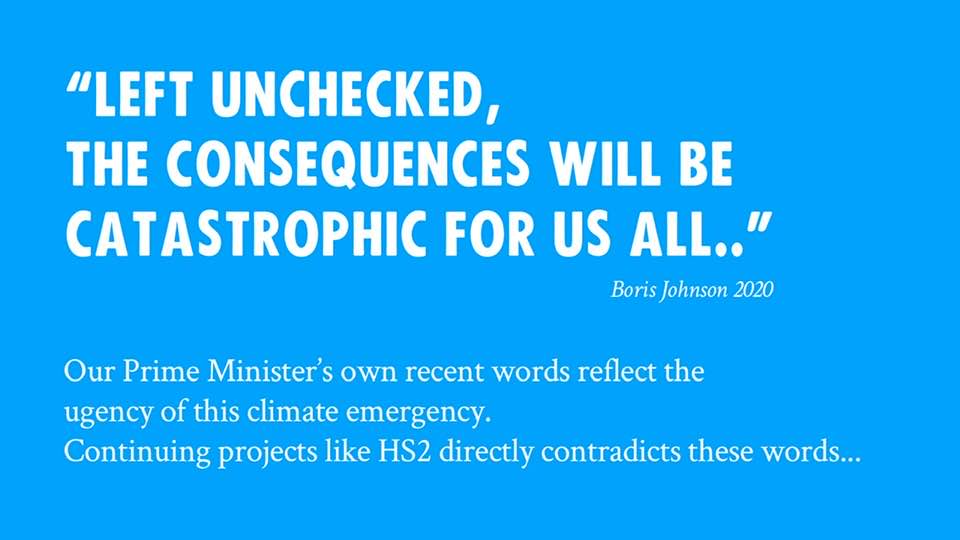
It is hard to imagine how this same man, who gleefully authorised the lawless tree-felling only a few months ago, can sleep peacefully at night after uttering such words. The PM has consistently lied about his real intentions regarding the HS2 project; clearly, his concern about the urgent loss of biodiversity does not extend to all the UK nature reserves and unique biodiversity he has authorised to be destroyed to make way for HS2! One wonders if he wasn’t thinking of this as he mentioned it is ‘happening today at a frightening rate’, as surely this is the case.
Meanwhile, I and my other anti-HS2 activist comrades continue to hope against hope that someone will finally take those non-bat licences seriously, and work on HS2 will be stopped for good. Until then, we have no option but to keep up the fight!
Addendum: I’ve just received the positive news that, thanks to the work of diligent activists recording and recording rare Barbastelle bat activity at Jones Hill Wood, authorities have forced the HS2 works to be paused until 2021, until full bat surveys are completed. Although HS2 can never be trusted, let’s hope they will be paused for good!
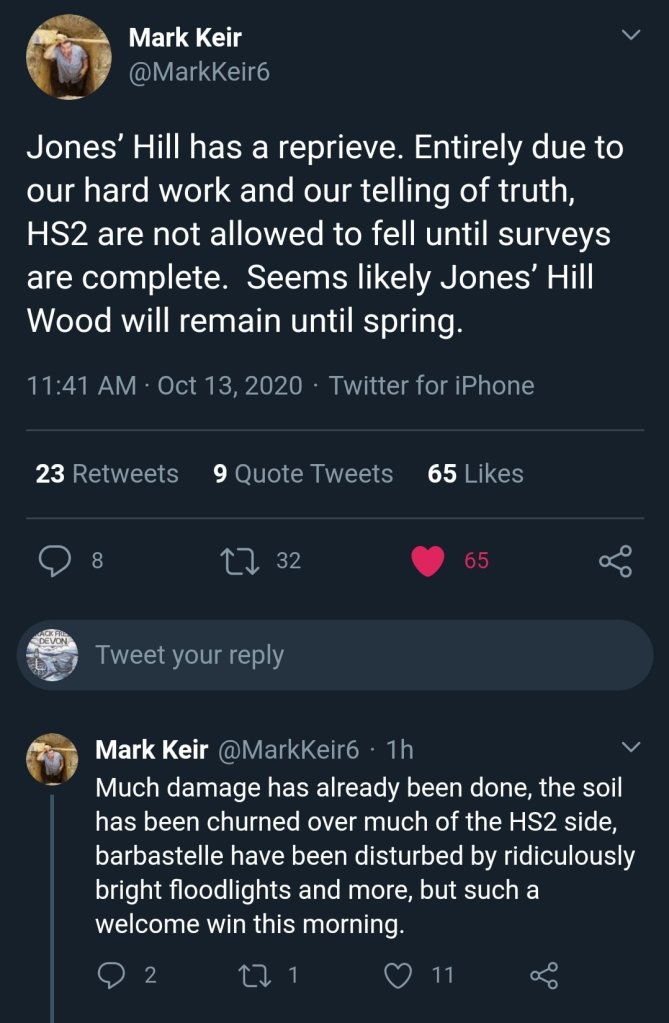


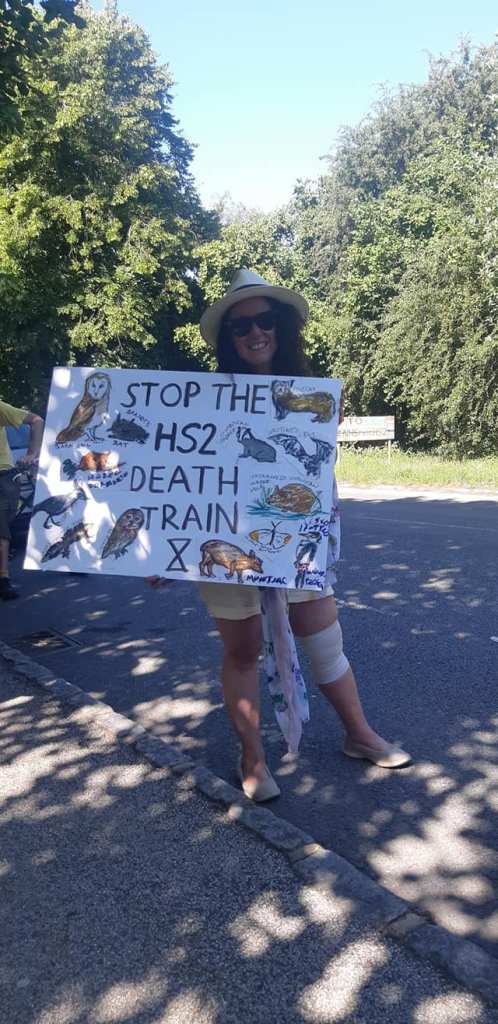
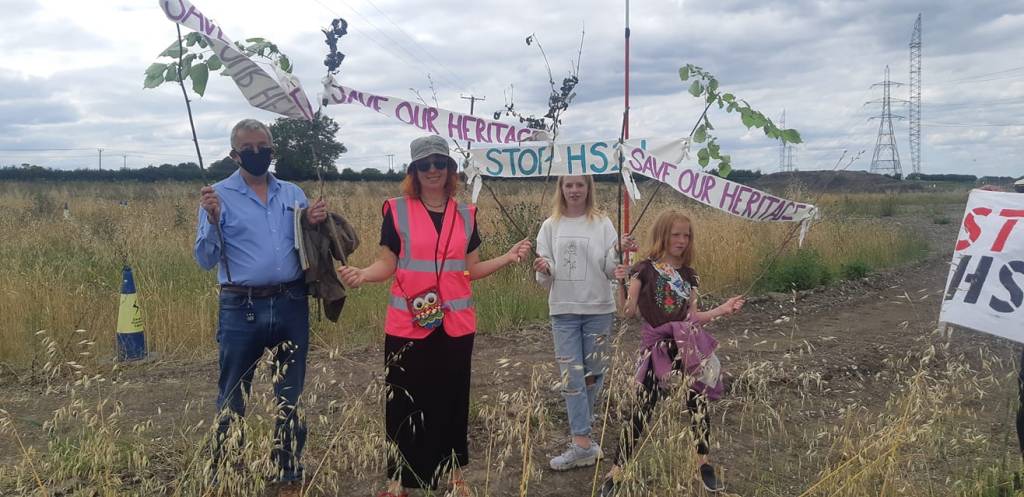

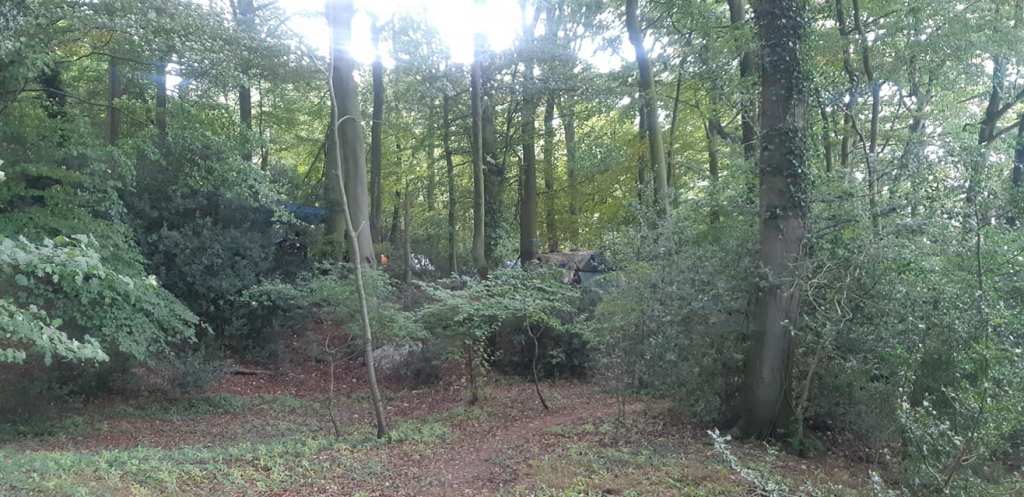

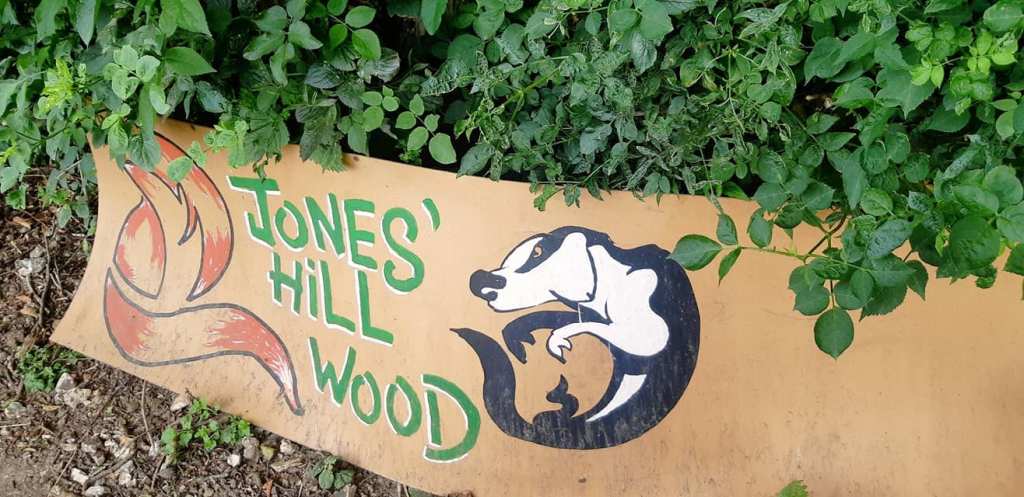
A very interesting and remarkable account of what it means to be a climate and environmental activist . Thank you .
LikeLike
Thank you Mel – and thanks too for all you do!
LikeLike
Wow! Thanks for this clear and tragic report. Yes, indeed, follow the money and you will find the answers as to who and why this is happening. Keep up the good work, we are proud of you.
LikeLike
Thanks Mum, appreciate that comment.
LikeLike
A great detailed article and wtitten in true Eco-warrior spirit! May God bless all your efforts and save our trees and bring the truth to light for all to see. Keep it going! 👍🏾
LikeLike
Thank you so much for reading, and for your comments. I hope it helped you understand in some ways why I have been actively doing this.
LikeLike
Thank you Liisa – appreciate you reading it and leaving a comment, and for your positive appraisal of the topic. Next post will be a little more light-hearted 🙂
LikeLike
It’s a pity you don’t have a donate button! I’d most certainly donate to this fantastic blog! I suppose for now i’ll settle for bookmarking and adding your RSS feed to my Google account. I look forward to new updates and will share this website with my Facebook group. Chat soon!
LikeLike
Hi Will,
I apologise for such a delayed response, but I do thank you for saying you would wish to contribute to this blog. I’ve covered a few other things and tend to add stuff sporadically on different topics, but I have a few environment-themed articles I have already written, which I intend to upload soon. I will also consider adding a donate button!
LikeLike